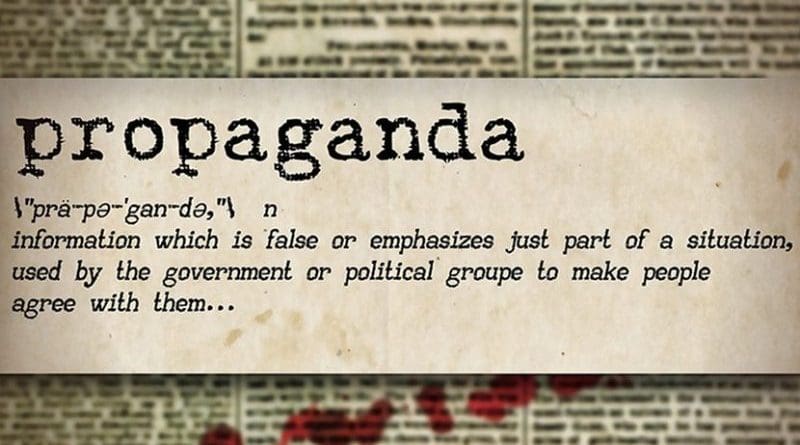The British Art Of Black Propaganda – OpEd
Never underestimate the potency, and deceptive malice, of the British political mind. In responding to the threat posed by Imperial Germany during the First World War, the British propaganda campaign made much of the atrocity tale, the nun raping German and the baby bayoneting Hun. The effectiveness of the campaign was so impressive it sowed doubt amongst a generation about the reliability of war crimes accounts.
In its efforts to try to win US support for its cause against Hitler in World War II, the train of British propaganda again operated with a concerted effect, demonising isolationists and denigrating supporters and members of the America First Committee. The great hope there was that Britain would fight the Germans to the last American. It led to one of the largest covert operations in UK history conducted under the auspices of an agency known as “British Security Coordination”. During the course of its operations, BSC subject matter entered the American political bloodstream, aided by the injecting activities of Walter Winchell, Drew Pearson, a radio station (WRUL) and the Overseas News Agency (ONA).
During the Cold War, the black propagandists were again in high demand. In 2021, the Observer revealed that the Information Research Department (IRD) had done its bit to egg on the massacres of communists and sympathisers in Indonesia in 1965. Pamphlets supposedly authored by seething Indonesian patriots but cooked up by the dark musings of the IRD, called for the elimination of the Indonesian communist party, the PKI. The deaths that followed numbered in the hundreds of thousands.
The IRD, which had, at its height in the mid-1960s, a staff of 360, had a primary purpose: to counter Soviet propaganda and its effects in Britain. It had its origins in the opening shots of the Cold War, established in 1948 but found itself behind the efforts of various sections of Whitehall already dedicated to the anti-Soviet effort.
Its program was more engaged and more ambitious than previously thought. “It’s very clear now,” Rory Cormac, an authority on subversion and intelligence history, explained to the Guardian, “that the UK engaged in more black propaganda than historians assume and these efforts were more systemic, ambitious and offensive. Despite official denials, [this] went far beyond merely exposing Soviet disinformation.”
The effects of propaganda can be perversely insidious. Allies or friendly nations can be used and abused if the aim is to advance the security of the propagandist. As Howard Becker laconically puts it in describing the consequences of black propaganda, “truth or falsity, as determined by any standard, is not raised. Propaganda which achieves its end may be entirely true, it may be entirely false; expedient rationality alone governs the choice of means.”
The IRD shows that, while it was more modest in scale to its US, Soviet and East European counterparts, it could hold its own in terms of inventiveness. It specialised in creating fake news sources and false statements designed to stir pots of racial tension, create instability, and foster social and political chaos.
A feature of the black propaganda campaign was the forging of statements by official Soviet bodies and entities. The Soviet-run news agency Novosti was something of a favourite, given the release of 11 fake statements supposedly authored by the body between 1965 and 1972.
In the wake of Israel’s lightning victory during the Six-Day War of 1967, the outfit drafted a number of documents claiming to be authored by disgruntled Muslim organisations sore at defeat and seeking answers. One did not have to look far for the culprit of godless Communism. “Why is the Arab nation at this time afflicted by so much sorry and disaster?” asks a statement purportedly issued from the League of Believers, a fictional Islamist organisation. “Why were the brave forces defeated in the jihad by the evil heathen Zionists?” The reason: that “we are departing from the right path, we are following the course chosen for us by the communist-atheists for whom religion is a form of social disease.”
Other material focused on existing and influential organisations, such as the Muslim Brotherhood. One pamphlet from the IRD, supposedly issued by the group, takes issue with the quality of Soviet weaponry. As for the Soviets themselves, they were “filthy-tongued atheists” who had little time for Egyptians, mere “peasants who lived all their lives nursing reactionary superstitions”.
In Africa, propaganda efforts were made to malign the activities of Soviet front organisations such as the World Federation of Democratic Youth. Nationalist, revolutionary figures were also targeted. A statement from early 1963, forged by the IRD, has the WFDY falsely accusing Africans of being morally feeble, uncivilised, and “primitive”. The theme is repeated in another forged statement three years later, and in a fake release by Novosti noting the poor quality of African students enrolled at an international university in Moscow.
These recent revelations do have a certain flavour of told-you-so obviousness, but serve as reminders that the news, however official, reeks when consulted between the lines (and lies). Cormac reminds us that the current UK foreign secretary, Liz Truss, has her own “government information cell”, a distant echo of the IRD. It pays to look behind the merits of the next news bulletin, if only to be disillusioned.

